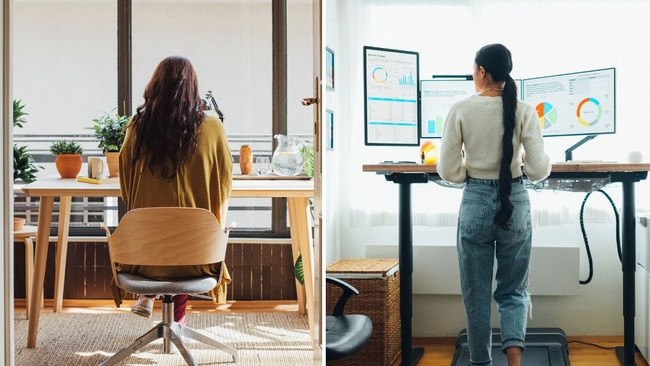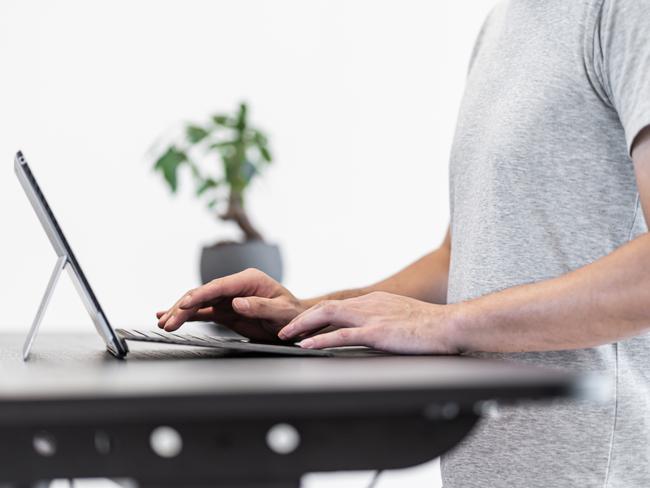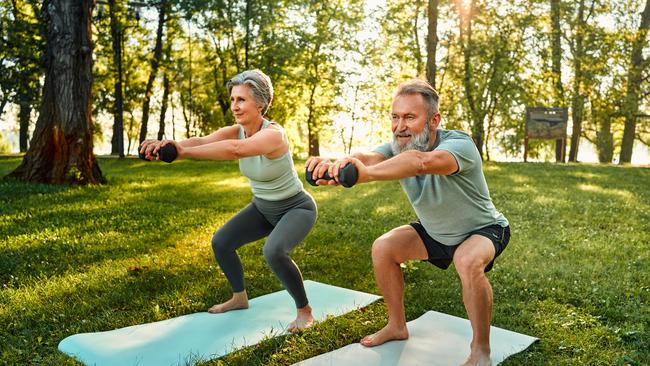What too much sitting is doing to your health
A new study shows that a sedentary lifestyle is even worse for us than we thought – but a standing desk won’t help.

We all know we spend far too much time sitting down. According to the NHS, UK adults spend an average of nine hours a day on our bottoms, which has a damaging effect on our metabolism, affecting our body’s ability to regulate blood sugar and blood pressure and to break down body fat. Now researchers have found that it can even speed up the ageing process.
Scientists at the University of Colorado (UC) have found that the more people sit, the stronger the signs of heart and metabolic ageing in their bodies. The team from the department of genetics, genomics and bioinformatics at UC tracked the weekly sitting and exercise hours of 1,327 participants, whose average age was 33, and found that they sat for an average 60 hours a week. They analysed key markers of heart and metabolic ageing, including their bad cholesterol levels and body mass index (BMI). In a paper published in the journal Plos One, they reported that those who sat for longer periods showed higher BMIs and other health risks, even when meeting the minimum recommended guidelines of about 20 minutes a day of moderate exercise.
A widely held belief is that if sitting is bad, then standing must be better. Because of this many of us have changed to a standing desk at work, or made sure we stand up on the hour when prompted by a fitness tracker. Yet researchers now believe that simply standing up from your chair does not offset the risks, and can be as damaging to metabolic health as sitting itself.
In a study involving more than 83,013 adults in the UK, which is published in the International Journal of Epidemiology journal this month, Emmanuel Stamatakis, professor of physical activity, lifestyle, and population health at the University of Sydney in Australia, found that standing does not reduce the risk of diseases such as stroke and heart failure. “Standing for long periods is not particularly health enhancing, and it may even come with increased circulatory disease risks,” he says.
According to the study, being on your feet for more than two hours a day increases the risk of developing blood clots in the legs and problems such as deep vein thrombosis and varicose veins. Stamatakis says that musculoskeletal problems such as back pain also increase when you spend 4-5 hours a day or more on your feet. “We need to shift our thinking to acknowledge that standing is also part of the problem of physical inactivity,” he says.
So if neither too much sitting nor too much standing is good for us, what can we do throughout our working days? Changing position regularly is important, but what is essential is that you factor in some movement. “Alternating frequency between sitting and standing is better than sitting or standing continuously as it requires some muscular contraction,” Stamatakis says. “But adding more movement is the real key, and it doesn’t matter if the movement sessions are brief and sporadic as long as they are interspersed across the day.” Here’s what to do:
1. A standing desk alone won’t help
Researchers at Curtin University in Australia reporting in the journal Ergonomics found that adults who stood for two hours while working experienced a 47 per cent increase in discomfort across all parts of their body regions, but particularly in the lower back and legs. According to Stamatakis, “our bodies are not made to be static for too long, with the exception of the times we rest after exercise and sleep, so alternating postures is key to preserving health”. So if you have a standing desk, you should sit down and stand up again at least every 20 minutes. “If used to increase the frequency of alternating between sitting and standing, so that you are increasing muscular contractions throughout the day, a standing desk is better than just sitting down,” Stamatakis says. “But standing desks on their own are not enough to prevent cardiometabolic and other problems.”

2. Take a walking ‘snack’ every 30 minutes
If you can manage a short stroll several times during the day, it could help to offset the harmful effects of prolonged sitting or standing, according to a study by exercise physiologists at Columbia University that was published last year. Keith Diaz, associate professor of behavioural medicine and lead author of the paper in Medicine & Science in Sports & Exercise journal, looked at the effects of different walking “snacks” on health, ranging from 60 seconds of walking after every 30 minutes of sitting to 5 minutes of walking every hour. It was a 5-minute walk every 30 minutes that brought the biggest benefits, lowering blood pressure and blood sugar and reducing blood sugar spikes after meals by 58 per cent compared with sitting down all day. “Our findings show that even small amounts of walking spread through the work day can significantly lower your risk of heart disease and other chronic illnesses,” Diaz says.
3. When you take a break, do some squats
Breaking up long periods of sitting or standing with regular squatting exercises is one of the best habits you can adopt for your health. Squats engage the glutes, hamstrings and quads, some of the largest muscles in the body, which burn calories and mop up excess sugars at a faster rate than smaller muscles during exercise. This year researchers from Zhejiang University in China and South-Eastern Finland University of Applied Sciences published findings in the Scandinavian Journal of Medicine and Science in Sports that suggested doing 100 squats a day – broken down as 10 every 45 minutes – significantly improves the body’s ability to control blood sugar, helping to reduce the long-term risk of type 2 diabetes. Other researchers reported in the Journal of Applied Physiology that a minute of squats during every hour of prolonged sitting could boost the brain’s cognitive and executive function.
“Movement of moderate to higher intensity, the kind that raises the heart rate and gets us out of breath if sustained for more than 20-30 seconds, is important to offset standing and sitting,” Stamatakis says. Squats or stair climbing are ideal if you are at the office, but you can even do lunges, jumping jacks and push-ups if working from home. “It doesn’t matter if the movements are brief and sporadic, performed in several short bouts lasting 1-3 minutes interspersed across the day, as long as we get them done,” he adds.

4. Don’t sit still – fidget
If you don’t have time for any significant exercise breaks then, as irritating as it might be to work colleagues, fidgeting in your seat will bring some benefits. Just tapping your toes, revolving your ankles and wriggling can help. Researchers at the University of Leeds and University College London analysed data on 12,778 women and found that those who described themselves as “moderately or very fidgety” were at no greater risk of premature death from longer sitting times than more active women. “It’s best to avoid sitting still for long periods of time, and even fidgeting may offer enough of a break to make a difference,” said Dr Gareth Hagger-Johnson, one of the study authors.
5. Switch to a kneeling or squatting position to watch TV
Periodically changing to a squatting or kneeling position when watching TV or working from home will engage underused muscles, according to researchers reporting in the Proceedings of the National Academies of Sciences. “Since light levels of muscle activity require fuel, which generally means burning fats, then squatting and kneeling postures may not be as harmful as sitting in chairs,” says David Rauchlen, a professor of biological sciences at the University of Southern California and the study author.
The Times



To join the conversation, please log in. Don't have an account? Register
Join the conversation, you are commenting as Logout